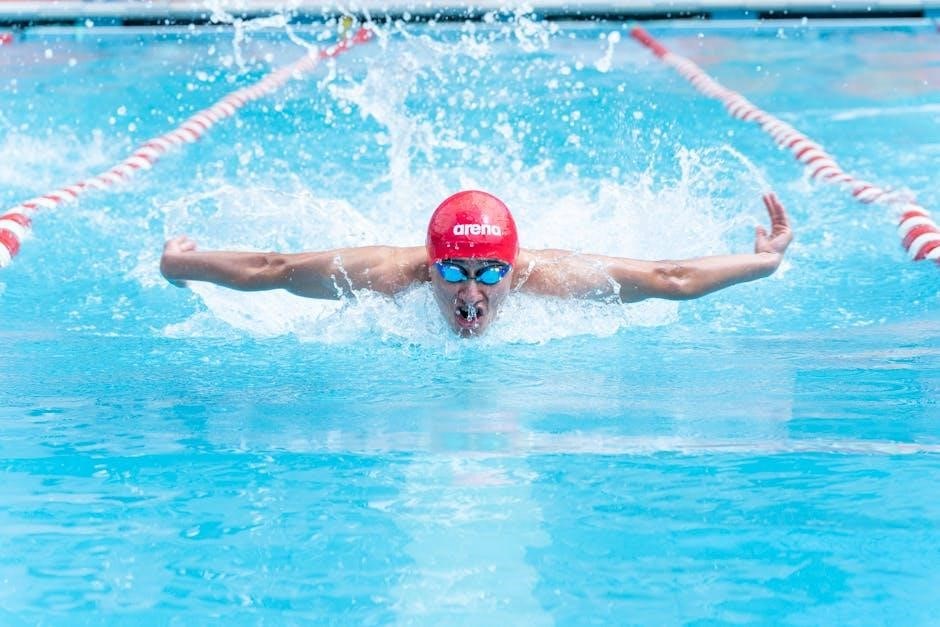This structured 4-week program enhances speed, strength, and power through targeted workouts. Each week focuses on different aspects, from foundational strength to max velocity, ensuring progressive improvement and customization.
Overview of the Program Structure
This 4-week speed training program is designed to progressively enhance speed, strength, and power. Each week is structured to target specific areas, ensuring a balanced approach to athletic development. Week 1 focuses on building foundational strength and speed through drills. Week 2 emphasizes acceleration and power with plyometric exercises and hill sprints. Week 3 concentrates on speed endurance, incorporating pro agility shuttles and long sprints. Finally, Week 4 maximizes velocity and refines technique with resisted sprints and race simulations. The program includes three workout days per week, with each day dedicated to speed, power, or strength. Progression is achieved by increasing reps, weight, or intensity while reducing rest periods. This structured approach ensures athletes improve efficiently and safely, with built-in recovery days to prevent overtraining.
Benefits of a 4-Week Speed Training Program
A well-structured 4-week speed training program offers numerous benefits for athletes and individuals seeking to enhance their performance. This program improves speed, acceleration, and endurance, making it ideal for sports requiring quick bursts of energy. Participants can expect enhanced muscle power and coordination due to the combination of plyometric exercises and strength training. The program also reduces the risk of injury by focusing on proper technique and stability. Additionally, it boosts overall athleticism, making everyday activities feel less strenuous. The structured approach ensures measurable progress, providing motivation and confidence. By the end of the program, individuals will notice significant improvements in their ability to perform at higher intensities. This program is a great way to take fitness to the next level in a short, focused timeframe.
Understanding the Importance of Speed in Athletics
Speed is a cornerstone of athletic performance, enabling athletes to excel in various sports by enhancing their ability to cover distances quickly and efficiently. It plays a pivotal role in sprinting, changing direction, and reacting swiftly during competitions. Athletes with superior speed often gain a competitive edge, as it allows them to outpace opponents and execute plays more effectively. In sports like soccer, basketball, and track, speed is crucial for success, as it directly impacts acceleration, agility, and overall performance. Developing speed also improves power and coordination, making it a vital component of training for athletes across disciplines. By prioritizing speed, athletes can achieve faster reaction times, better endurance, and enhanced overall athleticism, making it a fundamental focus in any sports training regimen.
Week 1: Building the Foundation
This phase focuses on establishing a solid base of strength, flexibility, and basic speed mechanics. It emphasizes proper form and gradual progression to prevent injury and build consistency.
Day 1: Strength Training
Day 1 focuses on building muscular strength, which is essential for generating power and speed. The session includes exercises like squats, lunges, and deadlifts to target the lower body, as well as push-ups and pull-ups for upper body strength. Core workouts such as planks and Russian twists are also incorporated to improve stability and balance. Each exercise is performed in sets of 4-6 repetitions with moderate to heavy weights. Proper form is emphasized to prevent injury. The goal is to create a strong foundation that supports explosive movements in the weeks ahead. Rest periods of 60-90 seconds are recommended between sets to allow for recovery. This day sets the stage for the more dynamic drills later in the program. Consistency and progression are key to maximizing gains. Pairing this with a balanced diet will enhance muscle repair and growth. Strength training is the cornerstone of this program.
Day 2: Speed Drills
Day 2 is dedicated to improving acceleration, agility, and technique through targeted speed drills. Exercises include high knees, butt kicks, and lateral shuffles to enhance neuromuscular coordination and explosive movement. Resistance band sprints and cone drills are also incorporated to refine proper running mechanics and change-of-direction speed. Each drill is performed in 3-4 sets of 10-20 yards, with rest periods of 30-60 seconds to maintain intensity. Emphasis is placed on maintaining proper posture, driving the ground forcefully, and minimizing unnecessary movements. These drills help athletes develop the ability to accelerate quickly and maintain speed over short distances. Consistency in execution is crucial for maximizing progress. By focusing on technique, athletes can optimize their natural speed potential and reduce the risk of injury. This day builds on the strength gained from Day 1 and prepares the body for more intense workouts in the coming weeks.
Day 3: Recovery and Mobility
Day 3 focuses on active recovery and improving mobility to enhance flexibility and reduce muscle tension. Activities include dynamic stretching, such as leg swings and hip circles, to increase blood flow and range of motion. Foam rolling and self-myofascial release are incorporated to alleviate muscle soreness and promote recovery. Low-intensity cardio, like jogging or cycling, is performed at a moderate pace to stimulate blood flow without overexerting the body. Mobility drills, such as lizard walks and spiderman stretches, target key areas like the hips and hamstrings. This day is crucial for allowing the body to repair and adapt after two days of intense training. Proper recovery ensures athletes can maintain consistency and performance throughout the program. Consistency in mobility work also enhances overall athleticism and reduces the risk of injury. This balanced approach supports long-term progress in speed and agility.

Week 2: Acceleration and Power
This phase focuses on enhancing explosive power and acceleration. It combines plyometrics, hill sprints, and core exercises to build strength and speed. Proper technique is emphasized to maximize gains and reduce injury risks. Athletes learn to generate force quickly, improving their ability to accelerate and decelerate effectively. The workouts are intense but structured to ensure progressive overload, leading to significant improvements in power output and speed by the end of the week. Consistency and attention to detail are key for optimal results.
Day 1: Plyometric Training
Plyometric training is a cornerstone of Week 2, focusing on explosive power and quick muscle contractions. Exercises like jump squats, box jumps, and burpees are central to this session. These movements enhance neuromuscular coordination and muscle elasticity, critical for rapid acceleration. Proper technique is emphasized to prevent injury and maximize results. Athletes perform 3-4 sets of 8-10 repetitions for each exercise, ensuring intensity matches the goal of building explosive speed. Plyometrics directly translate to improved sprinting ability by increasing force production and power output. This session is designed to challenge the athlete’s ability to generate and sustain explosive movements, laying the groundwork for the hill sprints and core work later in the week. Consistency and focus on form are key to achieving the desired improvements in acceleration and overall athleticism.
Day 2: Hill Sprints
Hill sprints are a key component of Week 2, targeting acceleration and power. Athletes sprint uphill at maximum effort for 20-30 seconds, focusing on explosive drive and proper running mechanics. The incline reduces stride length, emphasizing strength and force production. This exercise improves power output and acceleration, essential for quick starts and bursts of speed. Typically, 6-8 repetitions are performed with 1-2 minutes of rest between sprints to ensure full recovery. Hill sprints also enhance neuromuscular coordination and endurance, making them highly effective for improving speed and explosiveness. The controlled environment of hill sprints minimizes the risk of over-straining while maximizing benefits. Consistency in this workout is crucial for developing the raw power needed for acceleration in sports.
Day 3: Core and Stability Work
Core and stability exercises are essential for improving speed and overall athletic performance. This session focuses on strengthening the muscles of the trunk, including the abdominals, obliques, and lower back. A strong core provides stability and enhances power transfer during sprinting. Typical exercises include planks, Russian twists, and dynamic movements like bird dogs or pallof presses. These drills improve balance, posture, and rotational strength, all of which are critical for maintaining proper sprinting mechanics. Incorporating stability work also reduces the risk of injury by reinforcing the body’s foundation. Athletes should perform 3-4 sets of each exercise, holding or moving for 30-60 seconds. This session complements the explosive work from earlier in the week, ensuring a well-rounded development of speed and athleticism. Consistency in core training is vital for long-term improvements in speed and performance.

Week 3: Speed Endurance
Week 3 focuses on building speed endurance, enhancing stamina, and delaying fatigue. This phase helps athletes maintain top speed longer and recover faster between efforts.
Day 1: Pro Agility Shuttle

The Pro Agility Shuttle is a dynamic drill designed to enhance lateral speed, agility, and reaction time. Set up two cones 5-10 meters apart. Athletes start in a three-point stance at the center. On command, they sprint left or right, touch the cone, and quickly return to the center. This tests their ability to change direction explosively while maintaining balance. Incorporate variations like adding verbal cues or reaction commands to simulate game scenarios. Perform 3-5 sets of 5 reps in each direction, resting 60-90 seconds between sets. Focus on proper footwork and rapid acceleration to maximize efficiency. This drill not only improves speed endurance but also enhances overall athleticism and coordination, preparing athletes for high-intensity, multi-directional sports demands. Ensure proper warm-up and form to prevent injury and optimize performance benefits.
Day 2: Long Sprints
Long sprints are a cornerstone of speed endurance training, focusing on maintaining top speed over extended distances. Athletes perform 200-400 meter sprints at maximum effort, with 2-3 minutes of active recovery between sets. This drill builds muscular endurance, mental toughness, and the ability to sustain speed under fatigue. Proper warm-up is crucial, including dynamic stretches and short strides. Focus on maintaining form, especially arm swing and stride mechanics, to avoid injury and optimize performance. Incorporate 3-5 sets, adjusting distances based on individual fitness levels. Cool down with light jogging and static stretching to promote recovery. Long sprints enhance lactate threshold, delaying fatigue and improving overall speed endurance, making them indispensable for athletes in sports requiring sustained speed efforts. Ensure hydration and nutrition are prioritized to fuel performance and recovery effectively.
Day 3: Active Recovery
Active recovery is designed to promote healing and flexibility while maintaining light physical activity. This day focuses on low-intensity exercises such as light jogging, cycling, or swimming for 20-30 minutes. The goal is to enhance blood flow and reduce muscle soreness without overexerting. Incorporate stretching routines, including dynamic and static stretches, to improve range of motion and relieve tightness. Foam rolling or self-myofascial release can also be added to target specific muscle groups. Active recovery helps prevent overtraining and supports the body’s natural repair processes. It’s essential to keep the intensity low, allowing your body to recover while staying active. Proper hydration and nutrition are critical to maximize recovery benefits. This practice ensures you’re ready for the next phase of training while maintaining overall fitness.

Week 4: Max Velocity and Technique
This final week focuses on refining sprinting technique and maximizing speed. Emphasizes proper form, explosive power, and race-specific drills to optimize performance and prepare for peak output in competitions.
Day 1: Technique Drills
On Day 1 of Week 4, the focus shifts to refining sprinting technique to maximize velocity. Athletes perform high knees, butt kicks, and stride-outs to enhance form and efficiency. Drills like the “A” march and lateral shuffles improve coordination and explosiveness. Proper posture, leg drive, and arm swing are emphasized to maintain optimal sprint mechanics. These exercises are designed to ensure athletes can sustain top speed while maintaining proper form, reducing the risk of injury, and enhancing overall performance. The drills are progressive, increasing in intensity to build toward max velocity. Specific instructions include 3 sets of 20 meters for each drill, with rest periods to prevent fatigue. This session is crucial for translating strength and power into speed, ensuring athletes are prepared for peak performance in competitions.
Day 2: resisted Sprints
Day 2: Resisted Sprints
Day 2 of Week 4 focuses on resisted sprints to enhance power and speed endurance. Athletes use tools like resistance bands, parachutes, or weighted sleds to create additional load during sprints. These exercises strengthen the muscles used in sprinting, such as the hamstrings, quads, and glutes, while improving acceleration. The resistance forces athletes to generate more force with each stride, translating to increased speed when the resistance is removed. Drills include 3 sets of 20-30 meters with resistance, followed by 1-2 minutes of rest. Proper form and explosive drive are emphasized to maximize the effectiveness of the workout. This session is designed to build the strength and power needed for maintaining top speed over longer distances, preparing athletes for race simulations in the final days of the program.
Day 3: Race Simulation
Day 3 of Week 4 involves race simulation to mimic real-world competition conditions. Athletes perform sprints or runs that match their event’s specific demands, focusing on explosive starts, maintaining top speed, and proper form under fatigue. This session helps build mental resilience and sharpens race strategies, such as pacing and positioning. Coaches often incorporate staggered starts or head-to-head sprints to replicate race-day intensity. Athletes also practice transitioning between acceleration and max velocity seamlessly. Race simulations are tailored to the athlete’s event, whether it’s a 100-meter dash or a longer sprint. The goal is to refine technique, enhance race readiness, and boost confidence by replicating the pressures of competition. This final session prepares athletes to execute their skills effectively in real races, ensuring they’re mentally and physically prepared for peak performance.

Nutrition and Recovery
A balanced diet rich in lean proteins, complex carbs, and healthy fats fuels speed training. Adequate hydration and recovery techniques like stretching and foam rolling support muscle repair and performance.
Best Foods for Speed Training
Optimizing your diet with the right foods is essential for enhancing speed and performance. Focus on lean proteins like chicken, turkey, and fish, which aid in muscle repair and growth. Complex carbohydrates such as whole grains, sweet potatoes, and brown rice provide sustained energy. Incorporate healthy fats like avocados, nuts, and seeds for optimal muscle function. Hydration is key, so consume water-rich foods like cucumbers, oranges, and watermelon. For recovery, include bananas, berries, and Greek yogurt to replenish nutrients and reduce muscle soreness. Avoid processed foods and excessive sugar to maintain energy levels and performance. A balanced and strategic meal plan will fuel your workouts and support recovery, ensuring you maximize your speed training results. Proper nutrition is a cornerstone of achieving your goals in the 4-week program. Plan your meals wisely to enhance endurance and overall athletic performance.
Hydration Strategies
Proper hydration is critical for maximizing speed and endurance during training. Aim to drink at least 8-10 glasses of water daily, adjusting for sweat loss during workouts. Start hydrating 24-48 hours before training by consuming water-rich foods and clear fluids. On training days, drink 16-20 ounces of water 1-2 hours before starting and 7-10 ounces every 10-15 minutes during sessions. Sports drinks can be beneficial for high-intensity or prolonged workouts to replenish electrolytes. Post-workout, prioritize hydration within 30 minutes to aid recovery. Monitor urine color—pale yellow indicates proper hydration. Avoid overhydration to prevent hyponatremia. Incorporate hydrating foods like watermelon, oranges, and cucumbers into meals. Consistent hydration supports energy levels, muscle function, and overall performance, making it a vital component of your 4-week speed training program. Stay hydrated to unlock your full potential and maintain peak performance throughout the program.
Recovery Techniques

Effective recovery is essential to optimize performance and prevent injury during a 4-week speed training program. Incorporate foam rolling and stretching to improve muscle flexibility and reduce soreness. Ice baths or contrast showers can help reduce inflammation and promote muscle repair. Prioritize sleep, aiming for 7-9 hours nightly, as it is crucial for recovery and physical adaptation. Active recovery, such as light jogging or cycling, enhances blood flow without overexertion. Compression garments and massage tools can also aid in muscle recovery. Ensure recovery days are restorative, avoiding high-intensity activities. Consistency in recovery practices will enhance overall progress and allow your body to adapt to the demands of the program. By prioritizing recovery, you’ll maintain performance consistency and reduce the risk of overtraining. Make recovery a non-negotiable part of your routine for optimal results.

Progress Tracking and Adjustments
Monitor progress weekly through speed tests and performance metrics. Adjust training intensity or volume based on results to ensure continuous improvement and avoid plateaus. Stay adaptable.
Measuring Speed Improvements
Track speed improvements through timed sprints, agility drills, and technique assessments. Use a stopwatch or electronic timing system for precise measurements. Conduct baseline tests at the start and repeat weekly to monitor progress. Focus on reducing sprint times, improving acceleration, and enhancing overall agility. Consistency in testing conditions ensures accurate comparisons. Analyze data to identify strengths and areas needing improvement. Incorporate video analysis to assess running mechanics and technique. Heart rate monitoring can also provide insights into effort levels and recovery. Regular measurement helps maintain motivation and guides program adjustments. Celebrate small gains to stay motivated. Adjust training intensity or volume based on progress to avoid plateaus. By the end of the program, aim for measurable improvements in speed, power, and endurance. This data-driven approach ensures a clear path to achieving your speed goals effectively. Stay consistent and focused on the outcomes.

Adjusting the Program Based on Progress
Adjust the program based on individual progress to optimize results. If gaining speed quickly, increase intensity or volume. For plateaued athletes, modify drills or incorporate new challenges. Tailor training to address weaknesses revealed during progress tracking. For example, if acceleration lags, focus more on plyometrics or hill sprints. If endurance is lacking, extend sprint distances. Recovery time may need adjustment based on physical feedback. Stay flexible with the program to avoid overtraining or undertraining. Celebrate milestones to maintain motivation. Use data from speed tests and feedback to guide adjustments. Ensure adjustments align with long-term goals. Continuous adaptation keeps the program effective and engaging. Monitor progress weekly and make informed changes. This personalized approach enhances outcomes and keeps training dynamic. Adjustments should always prioritize proper form and technique to prevent injury and maximize gains. Stay proactive in tailoring the program for the best results. Consistent adaptation leads to consistent improvement.
Celebrate your progress and acknowledge the hard work invested. Stay committed to improving speed and agility. Use this foundation to achieve future goals and maintain consistent training. Stay proud of your dedication and keep pushing forward.
Final Tips for Success
To maximize the effectiveness of your 4-week speed training program, stay consistent and listen to your body. Ensure proper warm-ups and cool-downs to prevent injuries. Incorporate video analysis to refine your technique and identify areas for improvement. Prioritize nutrition by fueling your body with lean proteins, complex carbs, and healthy fats to support recovery and performance. Stay hydrated throughout the day, especially on training days. Aim for 7-9 hours of quality sleep nightly to aid muscle recovery and mental focus. Maintain a positive mindset and celebrate small victories along the way. Set realistic goals and adjust them as you progress. Finally, stay disciplined and committed to the program—consistency is key to achieving lasting results. By following these tips, you’ll be well-equipped to enhance your speed and overall athletic performance.

Next Steps After Completing the Program
After completing the 4-week speed training program, focus on maintaining and building on your progress. Gradually incorporate advanced speed drills and exercises into your routine to continue improving. Track your progress by periodically measuring your speed and agility. Set new, challenging goals to stay motivated and push yourself further. Consider integrating strength and endurance training to complement your speed gains. Schedule regular maintenance sessions to avoid losing the benefits achieved. Celebrate your accomplishments and share your success with others to stay motivated. If possible, join a community or group of athletes with similar goals for accountability and support. Finally, consult with a coach or trainer to create a long-term plan tailored to your specific needs and aspirations. This structured approach ensures sustained improvement and lasting results.
